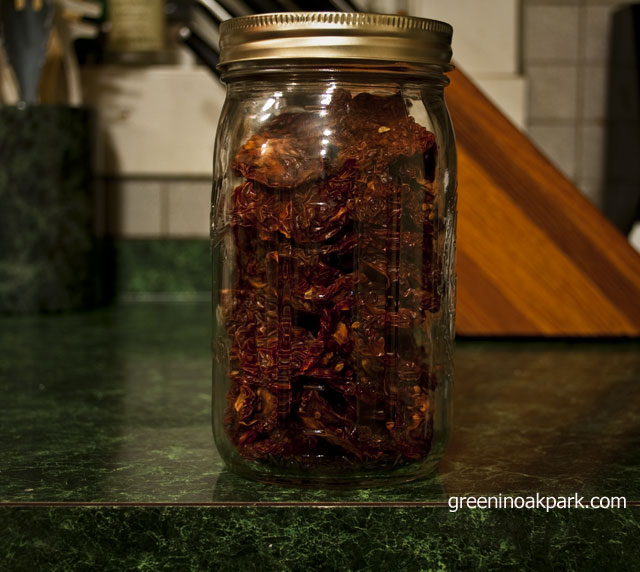Preserving food was not a skill I was taught when I was young, so what little I currently know, I’ve had to learn myself. One of easiest method of preserving food, aside from freezing, is dehydrating.
I posted this image once on a Wordless Wednesday. It’s a jar of sundried (read: dehydrated) tomatoes. Exciting, I know. 😉 They remind me of Shrinky-Dinks, and I suppose the concept is the same. I put the date on the label, but they’ll be good indefinitely as long as no appreciable moisture gets in the jar. It’s airtight, so it should keep just fine.
I’ve done this also with apples from last fall. They were meant to go into things such as yogurt and oatmeal, but they never made it there. They were eaten by the humans in the house long before that ever occurred. I will admit, it’s hard to resist the chewy, tart goodness that are dehydrated slices of Granny Smith apples. I’ll try again this fall and maybe I can ration them out… or maybe I’m fooling myself. We’ll see.
Dehydration is not suitable for all foodstuffs, of course, as some are better canning or pickling candidates. I have images of someone attempting to make powdered spaghetti sauce and salad. That’s likely a no-no. But you can dehydrate lots of types of veggies and pretty much any kind of fruit. I use a Nesco brand food dehydrator, and the tomatoes were simply cored and dehydrated at about 140 deg F until they were the right consistency – dry but flexible. Too dry and they’d become powder. Too moist and they wouldn’t keep. If you’ve ever bought sundried tomatoes at the store that were not packed in olive oil, that’s about the consistency you’re going for. The apples I mentioned above were cored, sliced into slices about an inch thick, soaked in water and lemon juice (ascorbic acid is better, but I didn’t have any) to prevent them from turning oxidizing and turning brown, and dehydrated for a few hours at about 150 deg F.
I’ve got some strawberries in the freezer and those will likely go into ice cream, but I’d like to dehydrate some for oatmeal and yogurt before the season is done. Ditto blueberries, and I may do the same for mangoes. If I have herbs left over from my deck planter, I’ll do those too, and I hope it makes the kitchen smell wonderful. It will be a great way effectively to extend the growing season during our cold Midwestern winters, and as a bonus, dehydrated food doesn’t take up much space.
Using a food dehydrator is the easiest method, but it’s not at all the only method, and in certain cases not the cheapest. If you live in the right climate, you can literally sun dry foods if the humidity is low and the temperatures is over 95 deg F for about 3 days in a row, but here in Illinois, it’s too humid when it’s 95 deg F. You folks in Arizona probably have it made when it comes to cheap food dehydration methods. You can use your oven as well, but it’s more energy-efficient and quicker to use a food dehydrator. Of course you’d have to buy one if you don’t have one, so if you don’t you can still use the oven.
For more information on drying food, check out this primer from the University of Illinois’ agriculture extension.





